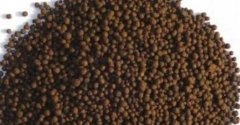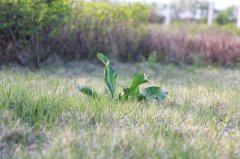Ecological environment management: the distribution of weeds in non-cultivated land and the importance of protecting ecological environment
Weed ecology and distribution: we can see weeds everywhere, so there are a lot of weeds in the land we plant, so how do you control weeds? Is to buy herbicides? This is not ecological. If you want to be eco-friendly, you'd better understand its ecology and distribution. Let's take a look at it.
In general, the species and quantity of weeds in the field vary greatly under different climates, crop species and field management methods. For example, the main weeds that make up water and upland fields have completely different grass phases because the degree of irrigation affects the soil water content; even if the orchards and vegetable fields are both dry fields, they are obviously different because of the length, plant type and competitiveness of crops. In addition, the seasonal distribution of winter-type and summer-type weeds will form a regional unique grass phase. Before rice preparation in the first stage of the province, there are a large number of winter-type dry-field weeds, such as Chenopodium ficifolium, Polygonumlapathifolium, Cardamine parviflora, etc., and barnyardgrass, autogenous rice and other Gramineae grasses under high temperature in the second stage. Whether the soil is prepared or not also has a significant effect on the appearance of grass in the field. For example, after the rice is harvested in winter, the field will grow xerophytic weeds one after another, and under the condition of soil preparation, the weeds will continue to grow, but after soil preparation, these budding weeds will be removed, and the weeds in the soil seed bank will be dug up to the soil surface, and the weeds will begin to sprout and grow under appropriate conditions. Therefore, in general, the amount of weeds in non-soil preparation fields is low, almost half of that of soil preparation, but under the condition of soil preparation, the growth of weeds is rapid, and the increase rate of fresh weight of grass is faster than that of soil preparation.
Most of the common weeds in paddy fields are water-bearing aquatic plants, that is, the roots are planted in the soil, and most of the aboveground branches and leaves are above water. In Taiwan, barnyardgrass (Echinochloa crusgalli), fluorlin (Scirpus juncoides), Artemisia annua (Cyperus difformis), Hedyotis diffusa (Monochoriavaginalis), wgnin timo tndo (Sagittaria trifolia), amaranth (Ammannia Baccifera), mother grass (Lindernia pyxidaria), red bone grass (Rotala indica), apical flower (Sphenochola Zeylanica) and Yunlin Guan grass (Scirpus planiculmis) are common weeds in paddy fields, while other floating weeds such as duckweed (Lemna paucicostata), locust leaf apple (Salvinia natans) and Manjianghong (Azoola pinnata) are common in paddy fields. Herbicides were also commonly used in rice fields before the extensive use of herbicides, but now they mostly occur in deeply flooded bamboo shoots or water chestnut fields.

Some hygrophytic plants, such as Echinochola colona, Leptochloa chinensis, Paspalum distichum, Cyperus iria, Lindernia cillata and Alternanthera sessilis, have gradually become important weed species in paddy field due to extensive soil preparation, poor management of flooding or water conservation, or spread from the ridge to the field. There is a great difference in climate temperature between the first and second stages of rice cropping in Taiwan, and there are also differences in the distribution of weeds between rice cropping stages. For example, Hedyotis diffusa, red bone grass, apical flower and millet are more in the second stage.
In addition, the differences in climate and management between the north and the south also lead to the local occurrence of weeds. For example, Yezi is isolated in the peach bamboo seedling area, Sagittaria pygmea is distributed in Yuanli and Dajia, amaranth and apical flowers occur more in the central and southern part of the country, while Yunlin Guancao is mainly in the central seawater field. But in recent years, under the prevalence of rice alternative tillage, agricultural machinery or seedlings contaminated by weed seeds or vegetative stems It will accelerate the spread of fertile weeds, at the same time, under the use of the same type of herbicide control, the difference of grass phase between regions has no obvious trend, such as Yunlin Guancao has been extended to Taitung, cusp flowers are also common in the northern field. The difference of temperature also affected the uniformity and growth of weed germination. The germination of weeds in the second stage was faster and consistent under high temperature. According to the results of Jiang Muyi's (1983) experiment, the vegetative growth rate such as plant height and biomass in 30 days after soil preparation was about the same as that in 60 days after soil preparation in the first stage.
The most common weeds in vegetable fields in dry and cold winter are broad-leaved grasses, including small and medium-sized annual grasses, including small and medium-sized annual grasses, including small and medium-sized annual grasses, such as Gnaphalium purpureum, Hemistepta lyrata, Polygonum polygonum, Polygonum plebeium, Rorippa atrovirens, goose intestines and Cardamine microphylla. If it is planted in winter after the second cropping stage, there will be some wet rice field weeds, such as Artemisia annua grass, lice grass (Fimbristylis milliacea) and so on.
The vegetable species cultivated in Taiwan include roots, stems, leaves, melons, fruits and vegetables, which have the characteristics of many species and small area. the distribution of weeds in all kinds of vegetables is obviously different because of the difference in growth season, growth period and management. in the hot and humid summer vegetable fields, the weeds are mainly grasses such as Eleusine indica, barnyardgrass and Digitaria sanguinalis. In addition, there are broad-leaved grasses such as wild amaranth (Amaranthus viridis), Canada canopy (Erigeron canadensis) and purslane (Portulaca oleracea), and crushed rice grass of Cyperaceae. According to the investigation of weeds in vegetable fields in high cold areas in summer, the weeds in vegetable fields include (Poa annua), European Huangyuan (Senecio vulgaris), bitter thistle (Sonchus oleraceus), Artemisia annua (Erigeron sumtrensis), Solanum nigrum (Solanm nigrum), Cardamine lobularis, Bromus catharticus, Malva neglecta and Erechtites valerianafolia, among which Kentucky bluegrass and goose intestines are the most common. However, cruciferous weeds such as Cardamine microphylla have become the dominant populations in the leisure period.
Due to the wide variety of leafy vegetables, the growth period of short-term and long-term leafy vegetables is only 19-20 days in summer and 30-45 days in winter, but the growth period of heading leafy vegetables such as cabbage, cabbage, lettuce and cabbage is more than 3 months, so the species and quantity of weeds in the two fields are also different. Perennial weeds are easy to appear in long growth period, such as Alternanthera sessilis and Cyperus rotundus, etc. Short-term leafy vegetables are less suitable for perennial grasses to complete their life cycle because of their short growth period and frequent soil ploughing after harvest. Because fruit trees are perennial crops, the growth period of deciduous or evergreen fruit trees is very long, and weed management is also extensive. In the hot and humid climate of the province, the grass phase in the park is quite complex, including perennial grass. However, in some high-lying sloping orchards, in order to give full play to soil and water conservation, increase the source of organic matter and change the biological phase, the herbaceous cultivation method of creeping dwarf weeds will be selected, which will relatively inhibit the occurrence of weeds in the orchard.
To sum up, the environment of paddy field is very uniform, the species of weeds is not as complex as that of dry field, and the change of grass phase is not great. The species of weeds in dryland crop fields are mainly affected by mild rainfall. In paddy fields, apart from temperature, the difference in oxygen supply caused by flooding depth is mainly caused by the difference in oxygen supply, but the use of herbicides is also an important influence of grass phase change. because when the same kind of herbicides are often used, the sensitive weeds decrease and the tolerable weeds increase and become the dominant population. It is possible that repeated application of the same herbicide for a long time may lead to resistant biotype (biotype) plants in sensitive populations due to gene mutations, such as Artemisia annua, a weed in dry land, has been proved to be resistant to paraquat (paraquat), so only large and small Artemisia annua can be found near crop fields where paraquat is the main control agent.
The importance of protecting the ecological environment: if we want to have a better home, we must pay attention to the importance of protecting the ecological environment.
- Prev

What is organic fertilizer? What are the types and characteristics of organic fertilizers?
What are the types and characteristics of organic fertilizers? Do you know? You want to know the following. Come and have a look. The sources of organic matter materials can be divided into two categories: one is farm organic fertilizer, the other is commercial organic fertilizer. The composition of farm organic fertilizer varies a lot, while
- Next

How to control perennial malignant weeds: weed control methods of how to control malignant weeds
Weed control, how to grow crops, there will be the existence of weed problems, then how to control weeds? You know what? if you don't know, let's get to know it. Interference of weeds on the normal growth of crops, and pests such as pathogens and insects (p
Related
- A one-day flower show brings 130 million yuan in orders! Nanhai, this Phalaenopsis exhibition is amazing
- What do the flower language and meaning of Lutheran tree mean? Precautions for planting Lutheran tree
- Encounter Chaoshan Kongfu tea, not without this cup of Phoenix single clump
- The durian market in Vietnam and Thailand is flooded. The price of imported durian has plummeted by 30-40% in a month.
- Shanghai solved the problem of local vegetable supply by planting 80,000 mu of green leafy vegetables.
- Wageningen University has become the best agricultural university in the world for the seventh time in a row.
- The strongest export season of South African grapes is full of challenges, with exports to Russia falling sharply by 21%.
- Sri Lanka is on the verge of bankruptcy, "Tea for debt" Organic Agriculture Revolution aggravates the Food crisis?
- Turning waste into earthworm manure and worm manure into organic fertilizer-A new choice for auxiliary farming
- Organic rice growers shoulder the responsibility of nurturing agricultural talents! Yinchuan Sustainable Farm with Organic Life Camp

